- 1Kafka最全知识总结(建议收藏)_kafka知识介绍
- 22024工作效率提升指南:免费AI工具助你轻松工作_pearocr
- 3大模型遇上心理健康咨询:MeChat、QiaoBan、SoulChat、MindChat四大心理健康领域微调模型总结
- 4【AIGC调研系列】通义千问、文心一言、抖音云雀、智谱清言、讯飞星火的特点分析_通义千问和文心一言哪个更好用
- 5React组件化_react 引用组件化
- 6pyspark的使用和操作(基础整理)_pyspark使用
- 7车载AIGC的内容创作解决方案,拓展无限可能
- 8CSS两种盒子模型_css和模型content和width区别
- 9高速固态存储卡学习资料第701篇:基于6U VPX XC7V690T的阵列M.2高速固态存储卡_vpx 板卡 复旦微690t方案
- 10Node.js 是什么以及gulp 构建Node.js 应用
从理论到实践:深度解读BIO、NIO、AIO的优缺点及使用场景_bio aio nio使用场景
赞
踩
BIO、NIO和AIO是Java编程语言中用于处理输入输出(IO)操作的三种不同的机制,它们分别代表同步阻塞I/O,同步非阻塞I/O和异步非阻塞I/O。
BIO
BIO(Blocking IO) 是最传统的IO模型,也称为同步阻塞IO。它实现的是同步阻塞模型,即服务器实现模式为一个连接一个线程,即客户端有连接请求时服务器端就需要启动一个线程进行处理。如果这个连接不做任何事情会造成不必要的线程开销,并且线程在进行IO操作期间是被阻塞的,无法进行其他任务。在高并发环境下,BIO的性能较差,因为它需要为每个连接创建一个线程,而且线程切换开销较大,不过可以通过线程池机制改善。BIO适合一些简单的、低频的、短连接的通信场景,例如HTTP请求。
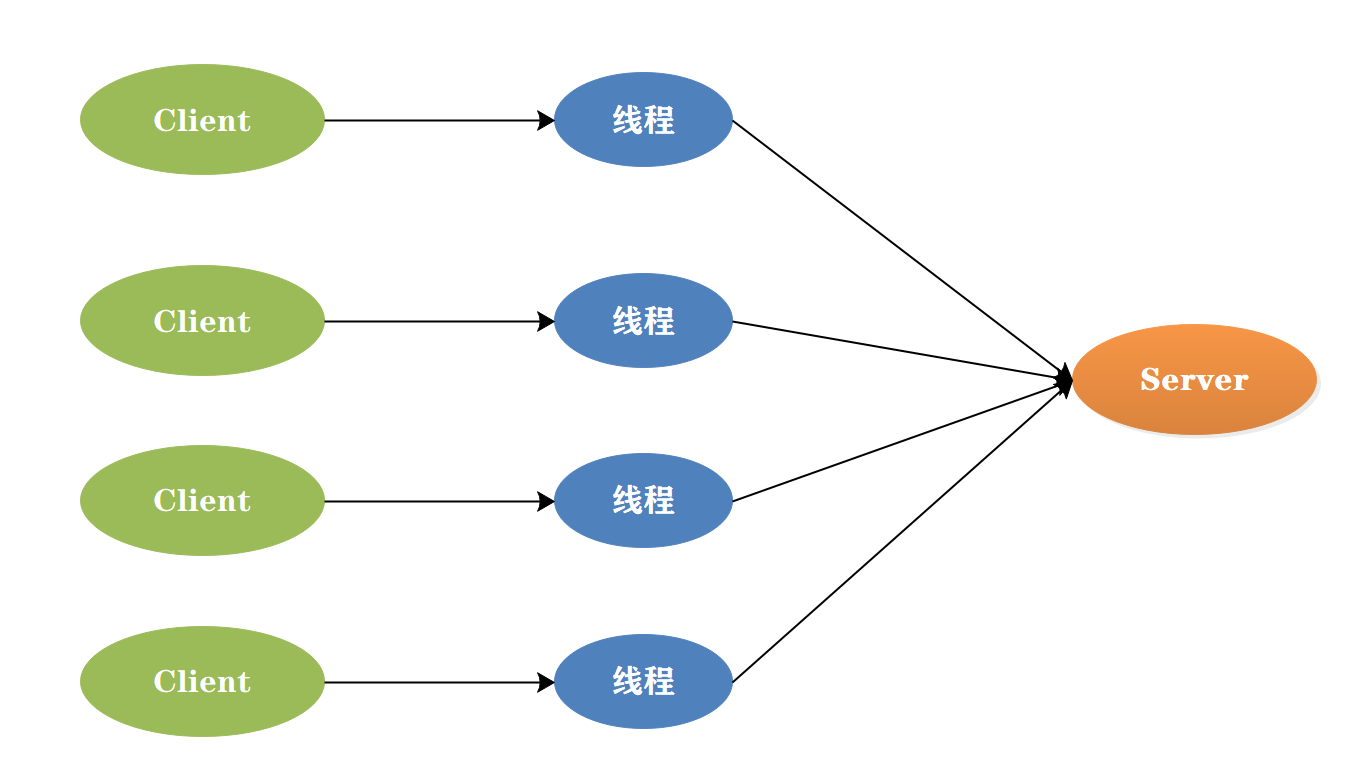
优缺点
优点:
- 简单易用: BIO模型的编程方式相对简单,易于理解和使用。
- 可靠性高: 由于阻塞特性,IO操作的结果是可靠的。
缺点:
- 阻塞等待: 当一个IO操作被阻塞时,线程会一直等待,无法执行其他任务,导致资源浪费。
- 并发能力有限: 每个连接都需要一个独立的线程,当连接数增加时,线程数量也会增加,造成资源消耗和性能下降。
- 由于I/O操作是同步的,客户端的连接需要等待服务器响应,会降低系统的整体性能。
示例代码
服务端代码:
import java.io.*; import java.net.*; public class BIOServer { public static void main(String[] args) throws IOException { ServerSocket serverSocket = null; Socket clientSocket = null; try { //创建服务端 serverSocket = new ServerSocket(8888); System.out.println("服务端已启动,等待客户端连接..."); while (true){ // 监听客户端请求,接收不到请求会一直等待 clientSocket = serverSocket.accept(); int port = clientSocket.getPort(); InetAddress inetAddress = clientSocket.getInetAddress(); System.out.println("客户端 "+inetAddress+":"+port+" 连接成功!"); //处理客户端消息 new Thread(new ServerThread(clientSocket)).start(); } } catch (IOException e) { System.out.println("客户端连接失败:" + e.getMessage()); } finally { try { if (clientSocket != null) { clientSocket.close(); } if (serverSocket != null) { serverSocket.close(); } } catch (IOException e) { System.out.println("关闭资源失败:" + e.getMessage()); } } } } /** * 服务端线程处理类 */ class ServerThread implements Runnable{ private Socket clientSocket; public ServerThread(Socket clientSocket) { this.clientSocket = clientSocket; } @Override public void run() { //获取客户端输入流以便接收客户端数据 try { BufferedReader in = new BufferedReader(new InputStreamReader(clientSocket.getInputStream())); //获取客户端输出流以便向客户端发送数据 PrintWriter out = new PrintWriter(clientSocket.getOutputStream()); int port = clientSocket.getPort(); InetAddress inetAddress = clientSocket.getInetAddress(); String address = inetAddress+":"+port; String inputLine; while ((inputLine = in.readLine()) != null) { //接收客户端消息 System.out.println("客户端"+address+"发来消息:" + inputLine); //给客户端发送消息 out.println("服务端已接收到消息并回复:"+inputLine); out.flush(); } } catch (IOException e) { e.printStackTrace(); } } }
- 1
- 2
- 3
- 4
- 5
- 6
- 7
- 8
- 9
- 10
- 11
- 12
- 13
- 14
- 15
- 16
- 17
- 18
- 19
- 20
- 21
- 22
- 23
- 24
- 25
- 26
- 27
- 28
- 29
- 30
- 31
- 32
- 33
- 34
- 35
- 36
- 37
- 38
- 39
- 40
- 41
- 42
- 43
- 44
- 45
- 46
- 47
- 48
- 49
- 50
- 51
- 52
- 53
- 54
- 55
- 56
- 57
- 58
- 59
- 60
- 61
- 62
- 63
- 64
- 65
- 66
- 67
- 68
- 69
- 70
- 71
- 72
- 73
- 74
- 75
客户端代码:
public class BIOClient { public static void main(String[] args) throws IOException { Socket clientSocket = null; BufferedReader in = null; PrintWriter out = null; try { //绑定服务端ip和端口号 clientSocket = new Socket("localhost", 8888); System.out.println("连接服务端成功!"); //获取输入流,接收服务端消息 in = new BufferedReader(new InputStreamReader(clientSocket.getInputStream())); //获取输出流,给服务端发送消息 out = new PrintWriter(clientSocket.getOutputStream(), true); Scanner scanner = new Scanner(System.in); while (true){ System.out.print("给服务端发送消息:"); String msg = scanner.nextLine(); out.println(msg); String response; if ((response = in.readLine()) != null) { //接收服务端响应 System.out.println("服务端响应:" + response); } } } catch (IOException e) { System.out.println("连接服务端失败:" + e.getMessage()); } finally { try { if (in != null) { in.close(); } if (out != null) { out.close(); } if (clientSocket != null) { clientSocket.close(); } } catch (IOException e) { System.out.println("关闭资源失败:" + e.getMessage()); } } } }
- 1
- 2
- 3
- 4
- 5
- 6
- 7
- 8
- 9
- 10
- 11
- 12
- 13
- 14
- 15
- 16
- 17
- 18
- 19
- 20
- 21
- 22
- 23
- 24
- 25
- 26
- 27
- 28
- 29
- 30
- 31
- 32
- 33
- 34
- 35
- 36
- 37
- 38
- 39
- 40
- 41
- 42
- 43
- 44
- 45
运行结果:
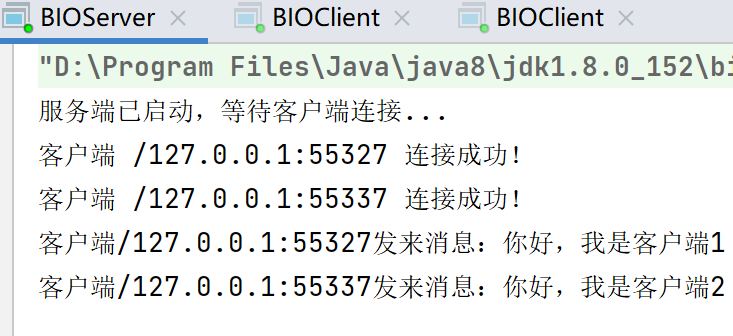
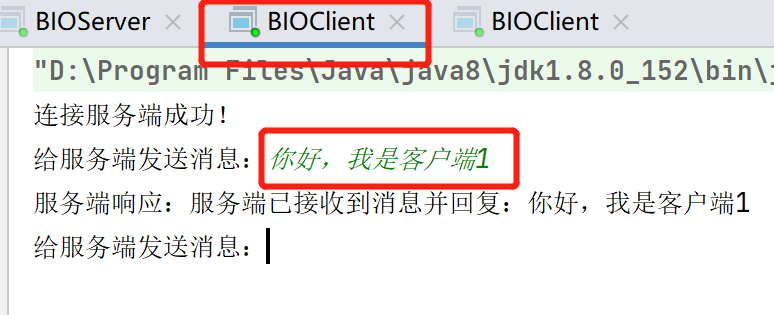

上述代码只是简单演示了如何使用BIO模型一个服务端接收并处理多个客户端请求情况。在这里创建了3个类,分别为服务端 BIOServer、多线程客户端处理类ServerThread和 客户端BIOClient,接着分别启动服务端BIOServer和两个客户端BIOClient,并在客户端中接收键盘输入的字符串发送给服务端,最后服务端把接收到的数据再返回给客户端。
由于BIO的特性,所以在服务端中需要为每个连接创建一个线程,也可以通过线程池进行优化,这里只是简单演示不做过多设计。
NIO
NIO是Java 1.4引入的新IO模型,也称为同步非阻塞IO,它提供了一种基于事件驱动的方式来处理I/O操作。
相比于传统的BIO模型,NIO采用了Channel、Buffer和Selector等组件,线程可以对某个IO事件进行监听,并继续执行其他任务,不需要阻塞等待。当IO事件就绪时,线程会得到通知,然后可以进行相应的操作,实现了非阻塞式的高伸缩性网络通信。在NIO模型中,数据总是从Channel读入Buffer,或者从Buffer写入Channel,这种模式提高了IO效率,并且可以充分利用系统资源。
NIO主要有三部分组成:选择器(Selector)、缓冲区(Buffer)和通道(Channel)。Channel是一个可以进行数据读写的对象,所有的数据都通过Buffer来处理,这种方式避免了直接将字节写入通道中,而是将数据写入包含一个或者多个字节的缓冲区。在多线程模式下,一个线程可以处理多个请求,这是通过将客户端的连接请求注册到多路复用器上,然后由多路复用器轮询到连接有I/O请求时进行处理。
对于NIO,如果从特性来看,它是非阻塞式IO,N是Non-Blocking的意思;如果从技术角度,NIO对于BIO来说是一个新技术,N的意思是New的意思。所以NIO也常常被称作Non-Blocking I/O或New I/O。
NIO适用于连接数目多且连接比较短(轻操作)的架构,例如聊天服务器、弹幕系统、服务器间通讯等。它通过引入非阻塞通道的概念,提高了系统的伸缩性和并发性能。同时,NIO的使用也简化了程序编写,提高了开发效率。
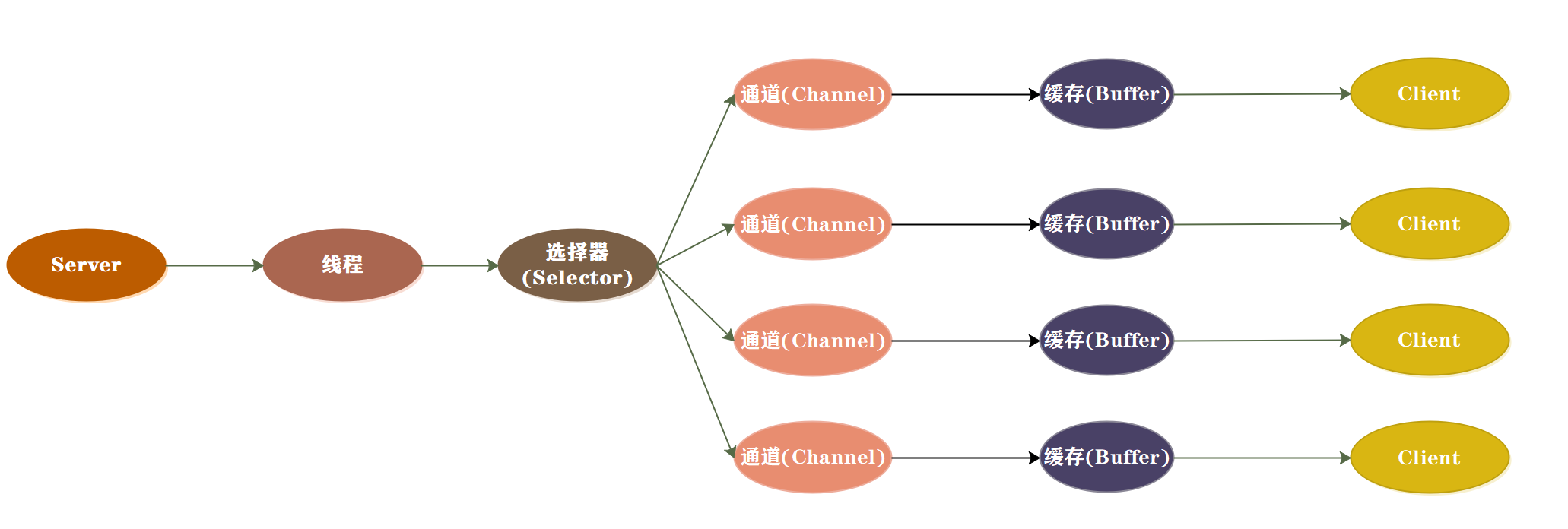
优缺点
优点:
- 高并发性: 使用选择器(Selector)和通道(Channel)的NIO模型可以在单个线程上处理多个连接,提供更高的并发性能。
- 节省资源: 相对于BIO,NIO需要更少的线程来处理相同数量的连接,节省了系统资源。
- 灵活性: NIO提供了多种类型的Channel和Buffer,可以根据需要选择适合的类型。NIO允许开发人员自定义协议、编解码器等组件,从而提高系统的灵活性和可扩展性。
- 高性能: NIO采用了基于通道和缓冲区的方式来读写数据,这种方式比传统的流模式更高效。可以减少数据拷贝次数,提高数据处理效率。
- 内存管理:NIO允许用户手动管理缓冲区的内存分配和回收,避免了传统I/O模型中的内存泄漏问题。
缺点:
- 编程复杂: 相对于BIO,NIO的编程方式更加复杂,需要理解选择器和缓冲区等概念,也需要考虑多线程处理和同步问题。
- 可靠性较低: NIO模型中,一个连接的读写操作是非阻塞的,无法保证IO操作的结果是可靠的,可能会出现部分读写或者错误的数据。
NIO适合一些复杂的、高频的、长连接的通信场景,例如聊天室、网络游戏等。
示例代码
在看代码之前先了解NIO中3个非常重要的组件,选择器(Selector)、缓冲区(Buffer) 和 通道(Channel):
-
通道(Channel):Channel是NIO中用于数据读写的双向通道,可以从通道中读取数据,也可以将数据写入通道。与传统的IO不同,Channel是双向的,可以同时进行读写操作,而传统的IO只能通过InputStream或OutputStream进行单向读写。Java NIO中常见的Channel有:FileChannel(文件读写)、DatagramChannel(UDP协议)、SocketChannel(TCP协议)和ServerSocketChannel(监听TCP连接请求)等。
-
缓冲区(Buffer): Buffer是NIO中用于存储数据的缓冲区,可以理解为一个容器,可以从中读取数据,也可以将数据写入其中。Buffer具有一组指针来跟踪当前位置、限制和容量等属性。Java NIO中提供了多种类型的Buffer,例如ByteBuffer、CharBuffer、ShortBuffer、IntBuffer等。每种类型的Buffer都有自己特定的读写方法,可以使用
get()和put()等方法来读写缓冲区中的数据。 -
选择器(Selector): Selector是NIO中用于监控多个Channel的选择器,可以实现单线程管理多个Channel。Selector可以检测多个Channel是否有事件发生,包括连接、接收、读取和写入等事件,并根据不同的事件类型进行相应处理。Selector可以有效地减少单线程管理多个Channel时的资源占用,提高程序的运行效率。
NIO的操作流程如下:
- 打开通道并设置为非阻塞模式。
- 将通道注册到选择器上,并指定感兴趣的事件类型(如连接打开、可读等)。
- 线程通过调用选择器的
select()方法等待事件发生。 - 当有一个或多个事件发生时,线程可以从选择器中获取已经准备好的通道,并进行相应的IO操作。
- IO操作完成后,关闭通道和选择器。
下面通过两段代码展示一下NIO的操作流程和使用方式。
服务端代码:
public class NIOServer { public static void main(String[] args) throws IOException { Selector selector = Selector.open(); // 创建一个ServerSocketChannel并绑定到指定的端口 ServerSocketChannel serverSocketChannel = ServerSocketChannel.open(); serverSocketChannel.bind(new InetSocketAddress(9999)); // 设置为非阻塞模式 serverSocketChannel.configureBlocking(false); // 将ServerSocketChannel注册到Selector上,并监听OP_ACCEPT事件 serverSocketChannel.register(selector, SelectionKey.OP_ACCEPT); System.out.println("服务器已启动,等待客户端连接..."); while (true) { // 阻塞,等待事件发生 selector.select(); Set<SelectionKey> selectedKeys = selector.selectedKeys(); Iterator<SelectionKey> keyIterator = selectedKeys.iterator(); while (keyIterator.hasNext()) { SelectionKey key = keyIterator.next(); if (key.isAcceptable()) { // 处理连接请求事件 SocketChannel client = serverSocketChannel.accept(); client.configureBlocking(false); //监听OP_ACCEPT事件 client.register(selector, SelectionKey.OP_READ); } else if (key.isReadable()) { SocketChannel client = (SocketChannel) key.channel(); client.getRemoteAddress(); //分配缓存区容量 ByteBuffer buffer = ByteBuffer.allocate(1024); client.read(buffer); String output = new String(buffer.array()).trim(); Socket socket = client.socket(); InetAddress inetAddress = socket.getInetAddress(); int port = socket.getPort(); String clientInfo = inetAddress+":"+port; String message = String.format("来自客户端 %s , 消息:%s", clientInfo , output); System.out.println(message); System.out.print("回复消息: "); writeMessage(selector, client, buffer); } keyIterator.remove(); } } } private static void writeMessage(Selector selector, SocketChannel client, ByteBuffer buffer) throws IOException { Scanner scanner = new Scanner(System.in); String message = scanner.nextLine(); buffer.clear(); buffer.put(message.getBytes()); //从写模式切换到读模式 buffer.flip(); while (buffer.hasRemaining()) { client.write(buffer); } // 重新监听OP_ACCEPT事件 client.register(selector, SelectionKey.OP_READ); } }
- 1
- 2
- 3
- 4
- 5
- 6
- 7
- 8
- 9
- 10
- 11
- 12
- 13
- 14
- 15
- 16
- 17
- 18
- 19
- 20
- 21
- 22
- 23
- 24
- 25
- 26
- 27
- 28
- 29
- 30
- 31
- 32
- 33
- 34
- 35
- 36
- 37
- 38
- 39
- 40
- 41
- 42
- 43
- 44
- 45
- 46
- 47
- 48
- 49
- 50
- 51
- 52
- 53
- 54
- 55
- 56
- 57
- 58
- 59
- 60
- 61
- 62
- 63
- 64
- 65
客户端代码:
/** * @author 公众号:索码理(suncodernote) */ public class NIOClient { public static void main(String[] args) throws IOException { Selector selector = Selector.open(); SocketChannel socketChannel = SocketChannel.open(); socketChannel.configureBlocking(false); socketChannel.connect(new InetSocketAddress("localhost", 9999)); socketChannel.register(selector, SelectionKey.OP_CONNECT); while (true) { selector.select(); Set<SelectionKey> selectedKeys = selector.selectedKeys(); Iterator<SelectionKey> keyIterator = selectedKeys.iterator(); while (keyIterator.hasNext()) { SelectionKey key = keyIterator.next(); if (key.isConnectable()) { SocketChannel client = (SocketChannel) key.channel(); if (client.isConnectionPending()) { client.finishConnect(); } System.out.print("Enter message to server: "); Scanner scanner = new Scanner(System.in); String message = scanner.nextLine(); ByteBuffer buffer = ByteBuffer.wrap(message.getBytes()); client.write(buffer); client.register(selector, SelectionKey.OP_READ); } else if (key.isReadable()) { SocketChannel client = (SocketChannel) key.channel(); ByteBuffer buffer = ByteBuffer.allocate(1024); client.read(buffer); String output = new String(buffer.array()).trim(); System.out.println("来自客户端的消息: " + output); System.out.print("输入消息: "); // 和服务端代码一样 writeMessage(selector, client, buffer); } keyIterator.remove(); } } } }
- 1
- 2
- 3
- 4
- 5
- 6
- 7
- 8
- 9
- 10
- 11
- 12
- 13
- 14
- 15
- 16
- 17
- 18
- 19
- 20
- 21
- 22
- 23
- 24
- 25
- 26
- 27
- 28
- 29
- 30
- 31
- 32
- 33
- 34
- 35
- 36
- 37
- 38
- 39
- 40
- 41
- 42
- 43
- 44
- 45
- 46
- 47
- 48
运行结果:
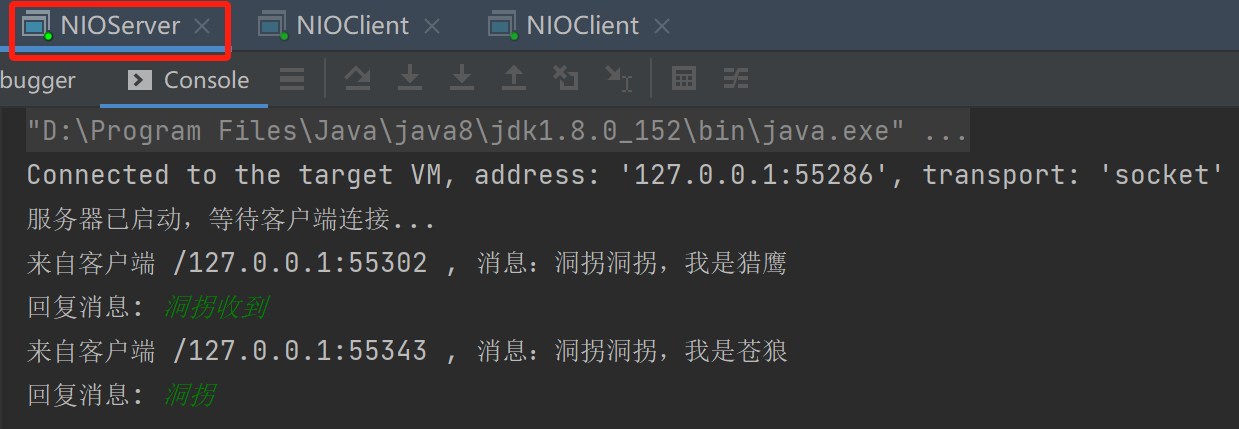


上面代码新建了两个类:服务端(NIOServer)和客户端(NIOClient), 通过上面代码和运行结果可以发现,在服务端和客户端进行通信时,我们并没有新建线程类进行通信,这也是NIO和BIO最大的区别之一。
需要注意的是,虽然NIO提高了系统的并发性能和伸缩性,但也带来了更高的编程复杂度和更难的调试问题。因此,在使用Java NIO时,需要仔细考虑其适用场景和编程模型。
AIO
Java AIO(Asynchronous I/O)是Java提供的异步非阻塞IO编程模型,从Java 7版本开始支持,AIO又称NIO 2.0。
相比于NIO模型,AIO模型更进一步地实现了异步非阻塞IO,提高了系统的并发性能和伸缩性。在NIO模型中,虽然可以通过多路复用器处理多个连接请求,但仍需要在每个连接上进行读写操作,这仍然存在一定的阻塞。而在AIO模型中,所有的IO操作都是异步的,不会阻塞任何线程,可以更好地利用系统资源。
AIO模型有以下特性:
- 异步能力:AIO模型的最大特性是异步能力,对于socket和I/O操作都有效。读写操作都是异步的,完成后会自动调用回调函数。
- 回调函数:在AIO模型中,当一个异步操作完成后,会通知相关线程进行后续处理,这种处理方式称为“回调”。回调函数可以由开发者自行定义,用于处理异步操作的结果。
- 非阻塞:AIO模型实现了完全的异步非阻塞IO,不会阻塞任何线程,可以更好地利用系统资源。
- 高性能:由于AIO模型的异步能力和非阻塞特性,它可以更好地处理高并发、高伸缩性的网络通信场景,进一步提高系统的性能和效率。
- 操作系统支持:AIO模型需要操作系统的支持,因此在不同的操作系统上可能会有不同的表现。在Linux内核2.6版本之后增加了对真正异步IO的实现。
优缺点
优点:
-
非阻塞:AIO的主要优点是它是非阻塞的。这意味着在读写操作进行时,程序可以继续执行其他任务。这对于需要处理大量并发连接的高性能服务器来说是非常有用的。
-
高效:由于AIO可以处理大量并发连接,因此它通常比同步I/O(例如Java的传统I/O和NIO)更高效。
-
简化编程模型:AIO使用了回调函数,这使得编程模型相对简单。当一个操作完成时,会自动调用回调函数,无需程序员手动检查和等待操作的完成。
缺点:
-
复杂性:虽然AIO的编程模型相对简单,但是由于其非阻塞的特性,编程复杂性可能会增加。例如,需要处理操作完成的通知,以及可能的并发问题。
-
资源消耗:AIO可能会消耗更多的系统资源。因为每个操作都需要创建一个回调函数,如果并发连接数非常大,可能会消耗大量的系统资源。
-
可移植性:AIO在某些平台上可能不可用或者性能不佳。因此,如果需要跨平台的可移植性,可能需要考虑使用其他I/O模型。
AIO适合一些极端的、超高频的、超长连接的通信场景,例如云计算、大数据等。
需要注意的是,目前AIO模型还没有广泛应用,Netty等网络框架仍然是基于NIO模型。
示例代码
服务端:
/** * @author 公众号:索码理(suncodernote) */ public class AIOServer { public static void main(String[] args) throws Exception { // 创建一个新的异步服务器套接字通道,绑定到指定的端口上 final AsynchronousServerSocketChannel serverChannel = AsynchronousServerSocketChannel.open().bind(new InetSocketAddress(5000)); System.out.println("服务端启动成,等待客户端连接。"); // 开始接受新的客户端连接 serverChannel.accept(null, new CompletionHandler<AsynchronousSocketChannel, Void>() { @Override public void completed(AsynchronousSocketChannel clientChannel, Void att) { // 当一个新的连接完成时,再次接受新的客户端连接 serverChannel.accept(null, this); // 创建一个新的缓冲区来读取数据 ByteBuffer buffer = ByteBuffer.allocate(1024); try { InetSocketAddress clientAddress = (InetSocketAddress) clientChannel.getRemoteAddress(); InetAddress clientIP = clientAddress.getAddress(); int clientPort = clientAddress.getPort(); System.out.println("客户端 "+ clientIP + ":" + clientPort + " 连接成功。"); } catch (IOException e) { e.printStackTrace(); } // 从异步套接字通道中读取数据 clientChannel.read(buffer, buffer, new ReadCompletionHandler(clientChannel)); } @Override public void failed(Throwable exc, Void attachment) { System.out.println("Failed to accept a connection"); } }); // 保持服务器开启 Thread.sleep(Integer.MAX_VALUE); } }
- 1
- 2
- 3
- 4
- 5
- 6
- 7
- 8
- 9
- 10
- 11
- 12
- 13
- 14
- 15
- 16
- 17
- 18
- 19
- 20
- 21
- 22
- 23
- 24
- 25
- 26
- 27
- 28
- 29
- 30
- 31
- 32
- 33
- 34
- 35
- 36
- 37
读处理程序:
/** * @author 公众号:索码理(suncodernote) */ public class ReadCompletionHandler implements CompletionHandler<Integer, ByteBuffer> { private AsynchronousSocketChannel channel; public ReadCompletionHandler(AsynchronousSocketChannel channel) { this.channel = channel; } @Override public void completed(Integer result, ByteBuffer attachment) { // 当读取完成时,反转缓冲区并打印出来 attachment.flip(); byte[] bytes = new byte[attachment.remaining()]; attachment.get(bytes); System.out.println("收到的消息: " + new String(bytes , StandardCharsets.UTF_8)); attachment.clear(); // 从键盘读取输入 Scanner scanner = new Scanner(System.in); System.out.print("输入消息: "); String message = scanner.nextLine(); System.out.println(); // 写入数据到异步套接字通道 channel.write(ByteBuffer.wrap(message.getBytes())); channel.read(attachment , attachment , new ReadCompletionHandler(channel)); } @Override public void failed(Throwable exc, ByteBuffer attachment) { System.out.println("Failed to read message"); } }
- 1
- 2
- 3
- 4
- 5
- 6
- 7
- 8
- 9
- 10
- 11
- 12
- 13
- 14
- 15
- 16
- 17
- 18
- 19
- 20
- 21
- 22
- 23
- 24
- 25
- 26
- 27
- 28
- 29
- 30
- 31
- 32
- 33
- 34
- 35
- 36
客户端:
/** * @author 公众号:索码理(suncodernote) */ public class AIOClient { public static void main(String[] args) throws Exception { // 创建一个新的异步套接字通道 AsynchronousSocketChannel clientChannel = AsynchronousSocketChannel.open(); // 连接到服务器 clientChannel.connect(new InetSocketAddress("localhost", 5000), null, new CompletionHandler<Void, Void>() { @Override public void completed(Void result, Void attachment) { System.out.println("连接到服务端成功。"); } @Override public void failed(Throwable exc, Void attachment) { System.out.println("Failed to connect server"); } }); // 从键盘读取输入 Scanner scanner = new Scanner(System.in); System.out.print("发送消息: "); String message = scanner.nextLine(); // 写入数据到异步套接字通道 clientChannel.write(ByteBuffer.wrap(message.getBytes()), null, new CompletionHandler<Integer, Void>() { @Override public void completed(Integer result, Void attachment) { ByteBuffer buffer = ByteBuffer.allocate(1024); clientChannel.read(buffer, buffer, new ReadCompletionHandler(clientChannel)); } @Override public void failed(Throwable exc, Void attachment) { System.out.println("Failed to write message"); } }); // 保持客户端开启 Thread.sleep(Integer.MAX_VALUE); } }
- 1
- 2
- 3
- 4
- 5
- 6
- 7
- 8
- 9
- 10
- 11
- 12
- 13
- 14
- 15
- 16
- 17
- 18
- 19
- 20
- 21
- 22
- 23
- 24
- 25
- 26
- 27
- 28
- 29
- 30
- 31
- 32
- 33
- 34
- 35
- 36
- 37
- 38
- 39
- 40
- 41
- 42
测试结果:
服务端界面:
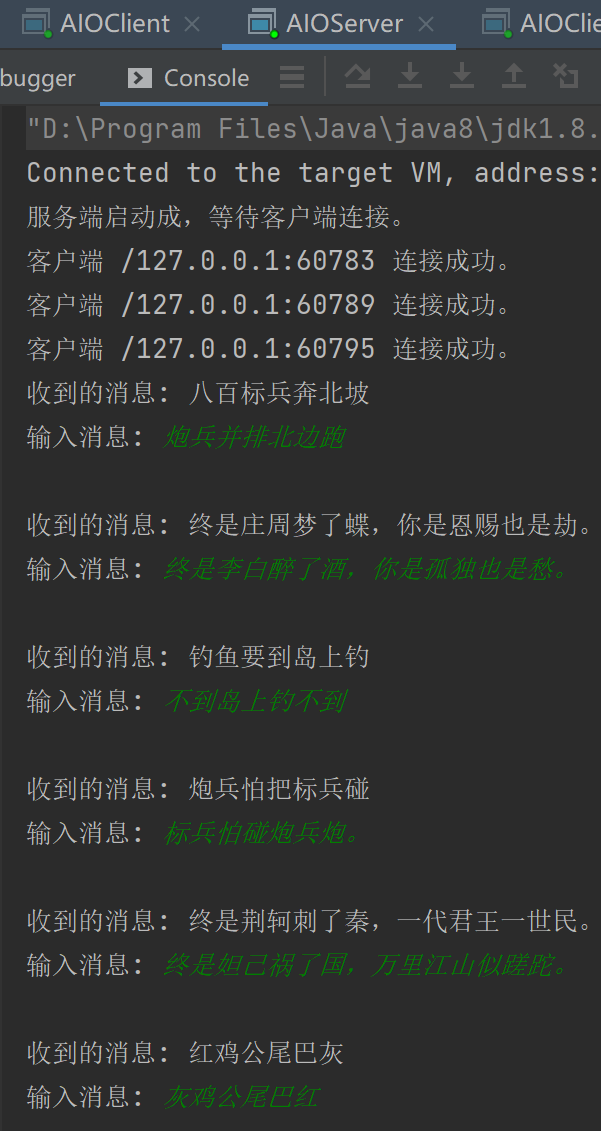
客户端1:
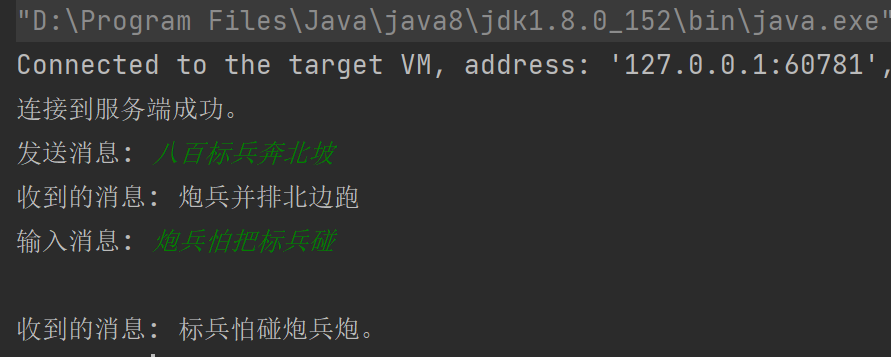
客户端2:
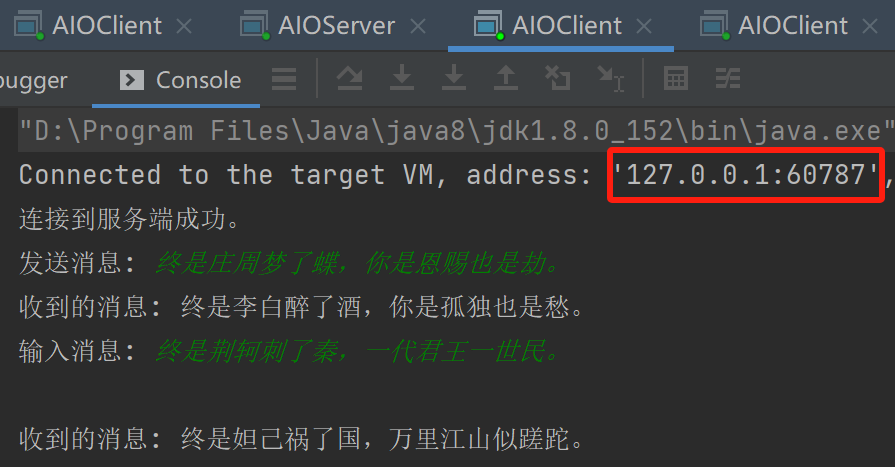
客户端3:
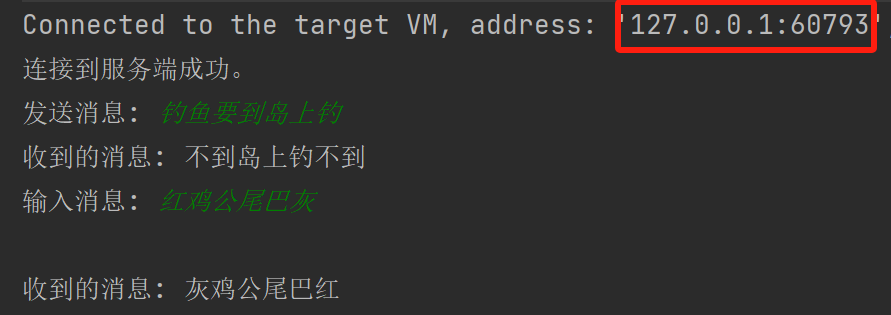
上述示例代码中,通过一个服务端(AIOServer)和3个客户端(AIOClient)的通信,简单演示了AIO的使用。可以发现,AIO和NIO的使用方式基本一致,数据都是从Channel读入Buffer,或者从Buffer写入Channel中,不同的是AIO是实现了异步非阻塞。
总结
Java中的BIO、NIO和AIO都是处理输入/输出(I/O)操作的模型,但它们在处理方式和效率上有所不同。
-
BIO(Blocking I/O):BIO是最传统的I/O模型,它的操作都是阻塞的。这意味着,当一个线程发起一个I/O操作后,必须等待操作完成才能进行其他任务。因此,BIO在处理大量并发连接时效率较低,但其编程模型简单。
-
NIO(Non-blocking I/O):NIO是非阻塞的I/O模型,它允许线程在等待I/O操作完成时进行其他任务。NIO引入了Channel和Buffer的概念,以及Selector用于多路复用。NIO适合处理大量并发连接,但其编程模型相对复杂。
-
AIO(Asynchronous I/O):AIO是真正的异步I/O模型,应用程序无需等待I/O操作的完成,当操作完成时,操作系统会通知应用程序。AIO使用回调函数或Future对象来获取操作结果,适合处理大量并发连接,其编程模型相对简单。
总之,BIO、NIO和AIO各有优缺点,适用的场景也不同。BIO适合连接数目较少且固定的架构,NIO适合连接数目多,但是并发读写操作相对较少的场景,AIO则适合连接数目多,且并发读写操作也多的场景。在选择使用哪种I/O模型时,需要根据具体的应用场景和需求进行权衡。



